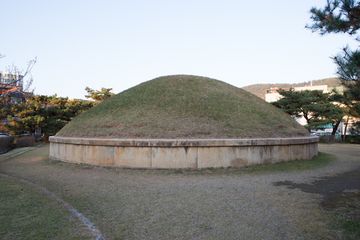경주 용강동 고분
| 경주 용강동 고분 Ancient Tomb in Yonggang-dong, Gyeongju |
|
 경주 용강동 고분, 국가문화유산포털, 문화재청. |
|
| 대표명칭 | 경주 용강동 고분 |
|---|---|
| 영문명칭 | Ancient Tomb in Yonggang-dong, Gyeongju |
| 한자 | 慶州 龍江洞 古墳 |
| 주소 | 경북 경주시 용강동 1130-2번지 3필 |
| 지정(등록) 종목 | 사적 제328호 |
| 지정(등록)일 | 1989년 1월 14일 |
| 분류 | 유적건조물/무덤/무덤/봉토묘 |
| 시대 | 통일신라 |
| 수량/면적 | 1,800㎡ |
| 웹사이트 | 경주 용강동 고분, 국가문화유산포털, 문화재청. |
|
|
|
해설문
국문
경주 중심부에서 북천(北川) 너머 평지에 단독으로 조성된 고분이다. 1986년 경주고적발굴조사단이 조사하여 굴식돌방무덤[횡혈식석실분, 橫穴式石室墳]임을 확인하였다.
돌방 내부에서는 돌로 만든 베개, 발받침, 어깨받침 등이 출토되어 시신을 널에 넣지 않고 안치하였음을 알 수 있었다. 각종 토기류와 토용(土俑)*, 청동제 십이지신상(十二支神像) 등이 출토되었다. 토용은 12~21cm 크기로 홀(笏)*을 가진 문인상과 무인상, 여인상으로 일부는 물감으로 채색되어 있었다. 십이지상은 각각 방위에 맞게 배치되어 있었는데, 이는 당나라의 무덤에서도 확인되는 것이어서 신라와 당의 교류관계를 보여준다.
무덤 주인과 시대를 알려주는 직접적인 자료는 없으나, 출토유물로 볼 때 7세기 후반부터 8세기 전반 사이에 조성된 신라 진골(眞骨) 귀족의 무덤으로 추정된다. 출토된 토용과 청동제 십이지상은 무덤 안에서 처음 발견된 것으로 신라 무덤, 당나라와의 문물교류, 신라 복식사 연구에 아주 중요한 자료가 되고 있다.
- 토용(土俑) : 사람의 모습을 흙으로 구워 만들어 순장(殉葬)을 대신해 무덤에 넣은 것
- 홀(笏) : 신하가 임금을 만날 때 예를 갖추기 위해 두 손에 모아 쥐던 물건
영문
Ancient Tomb in Yonggang-dong, Gyeongju
This burial mound, located to the north of Bukcheon Stream in downtown Gyeongju, is presumed to date to the late 7th or early 8th centuries during the Unified Silla period (668-935). It is thought to belong to a member of the “true bone” rank of the Silla aristocracy.
The burial mound was excavated in 1986. A stone chamber tomb with corridor was discovered inside. A stone pillow, stone foot rest, and stone shoulder rest were found in the chamber, suggesting that there was no coffin. Various earthenware, clay figurines, and gilt-bronze statues of the twelve zodiac animals were excavated from the tomb.
This was the first tomb from which clay figurines and gilt-bronze statues of the twelve zodiac animals were excavated. The clay figurines depict civil officials holding scepters, military officials, and women. They range from 12-21 cm in height and some are painted. The zodiac animal statues were found positioned in the tomb according to the cardinal direction with which they are each associated. This is a feature found in tombs from Tang China, suggesting cultural exchange between the Tang and Silla kingdoms. The figurines and statues are also useful in the study of Silla costume.